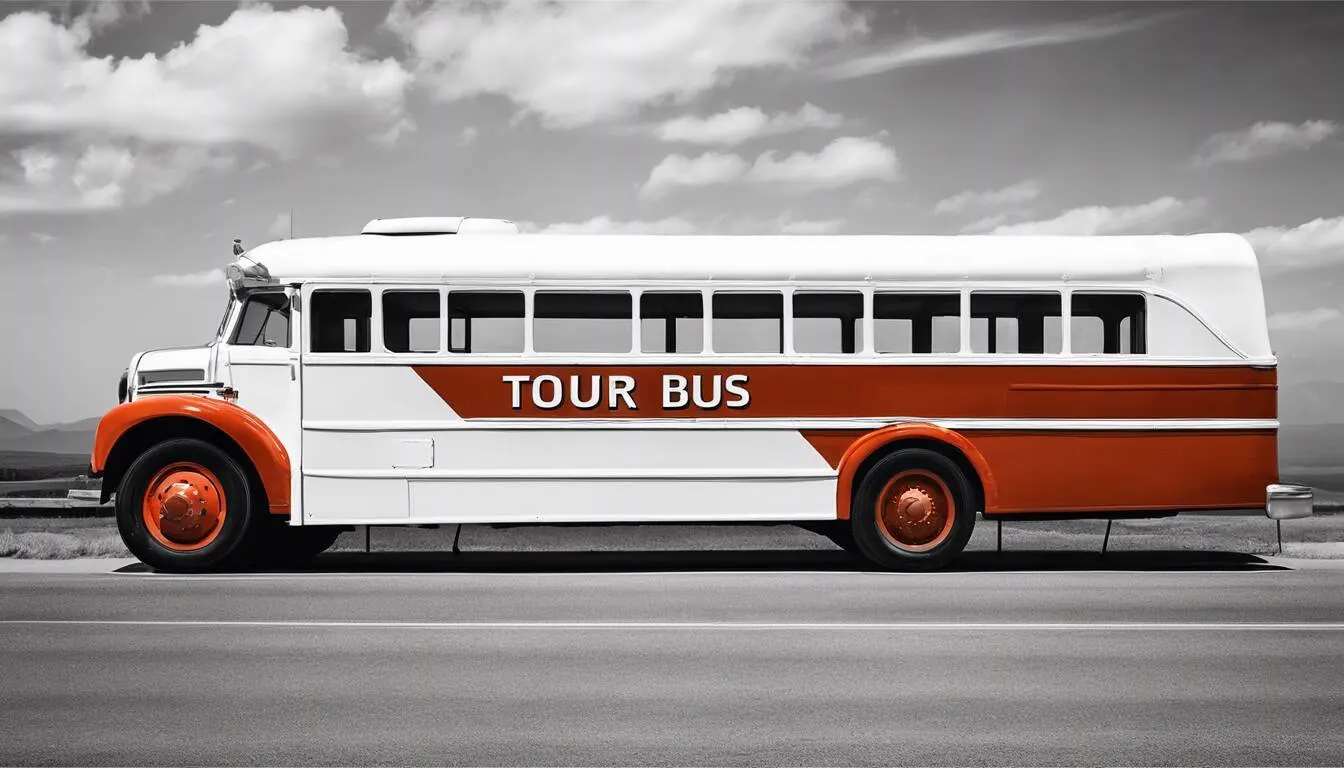If you’re passionate about travel and love the idea of exploring new places without the hassle of organizing accommodations, a tour bus might be your best bet. But what exactly is a tour bus, you ask? Imagine a hotel on wheels that not only takes you to exciting destinations but also provides you with comfort and convenience each step of the journey. Stick with us as we delve into the world of tour buses, highlighting key features and revealing why they complete your puzzle for a perfect vacation!
A tour bus is a type of bus that is designed to transport groups, typically for sightseeing or long-distance travel. It often features luxurious accommodations such as reclining seats, WiFi, TVs, and ample storage space for luggage. Tour buses are commonly used by holiday tour operators, entertainers, and other groups traveling long distances. They offer comfortable and convenient transportation options for both leisure and professional purposes.

Table of Contents
Understanding What Constitutes a Tour Bus
In its simplest sense, a tour bus is a motor vehicle designed to transport passengers on extended trips for recreational or commercial purposes. When it comes to defining what constitutes a tour bus, however, the answer becomes more complicated due to the many types and variations available.
In general, though, tour buses are typically chartered for long-distance travel with overnight stays. They come equipped with seating and accommodations that far exceed what you might find in standard passenger vehicles.
Seating and Accommodation Features
Tour buses are designed to offer both comfort and practicality, providing amenities that make lengthy road trips more manageable.
For instance, seating features may range from traditional benches to recliners with ample legroom, and some even have tables for working or playing games. Additionally, most tour buses include features like air conditioning, heat and ventilation systems to keep passengers comfortable in any weather conditions.
But what sets tour buses apart is also their accommodation space which can feature bunk beds, a master suite, a full bathroom(s). Many luxury offers lounge areas complete with kitchens where travelers can cook meals on the go without having to stop at expensive restaurants. GPS and other technological driving aids make navigating unfamiliar roads much easier, while onboard Wifi keeps guests connected online during long trips.
| Features | Description |
|---|---|
| Seating capacity | Typically 35-40 seats |
| Engines | These vary based on manufacturer preference but often use diesel fuel |
| Restrooms | All tour buses have bathroom facilities onboard |
| Sleeping quarters | Depending on the client’s preferences, sleeping quarters may include bunk beds/staterooms with built-in TVs/DVD players |
| Kitchen facilities | Luxury tour buses feature kitchens that provide space for food storage/cooking facilities |
Furthermore, since bands and performers often use these vehicles as mobile homes while touring around the country on concert tours, they may have additional rooms or compartments for equipment and musical instruments. In summary, tour buses offer luxury features that make long-distance travel comfortable and convenient.
Purposes and Clients of Tour Buses
Tour buses are not your everyday mode of transport, given their specialized nature. They are primarily used for sightseeing, holiday tours, events transportation, and even by celebrities or sports teams on long-distance travel. These vehicles have specific features that cater to the unique needs of their clients, such as comfortable seating arrangements, storage compartments, entertainment features like WIFI connectivity, televisions screens, refrigerators and kitchenettes. Charter bus companies can customize the interior features to meet the needs of their clientele.
- Tour buses are specialized vehicles that cater to the unique needs of sightseers, holiday tours, event transportation, and even celebrities or sports teams. They offer features like comfortable seating, storage compartments, entertainment options, and customizable interiors to meet client demands.
City Tours and Sightseeing Services
City tours and sightseeing are some of the most popular uses for tour buses. These services are widely available in most major cities around the world because they offer a convenient way to see all the sights without having to worry about finding parking or navigating narrow streets. Tourists can relax in comfortable seats while being taken through famous tourist attractions while listening to an experienced guide. The vehicles feature wide windows that allow tourists to enjoy panoramic views with ample space for storage, meaning they need not worry about carrying luggage around on a city exploration trip.
For instance, a Berlin tour bus may enable visitors to explore historic landmarks such as the Berlin Wall or Brandenburg Gate while appreciating scenic views overlooking the city’s beautiful skyline. The tourists’ experience is often enhanced by a knowledgeable tour guide who offers commentary on historical sites and other cultural points of interest.
Tour buses also offer a convenient way for groups attending events to move along designated event routes quickly. Whether it’s picking up participants from several locations or transporting them between different venues during an event day, travel logistics become much easier.
Some examples of clients renting tour buses include:
- Tourists visiting new places
- Bridal parties or wedding guests
- Sporting teams traveling for tournaments
- Entertainment acts going from one show to another
- Large families traveling together
- Corporate groups attending conferences and meetings
While it’s evident that tour buses have their advantages, they also come with a few disadvantages. For instance, while they can accommodate large groups, customized arrangements may be quite expensive for smaller groups without budgeting for customizations. There’s also limited flexibility on the part of tourists to deviate from pre-planned routes or visit out-of-the-way places.
Overall, however, tour buses remain an excellent option for people who want to explore new destinations conveniently and in comfort while enjoying picturesque views and having fun.
- According to the American Bus Association, in 2019, there were approximately 36,000 motorcoaches (which include tour buses) operating in the United States.
- A research conducted by Chaddick Institute for Metropolitan Development in 2019 found that buses, particularly tour buses and charter buses, are one of the safest modes of transportation with an accident rate of only 0.05 accidents per million passenger miles.
- The Federal Motor Carrier Safety Administration reports that as of 2023, modern tour buses may see up to 15% improvements in fuel efficiency due to technological advancements.
Events and Group Transportation Services
Tour buses are a popular mode of transportation for events and group transportation services. They offer comfort, amenities, and convenience that make it easy to transport groups of people in comfort and style. This is particularly beneficial when organizing large events such as school trips, weddings, sports competitions, professional conferences or even family holidays. By providing ample seats and onboard entertainment, tour buses are becoming increasingly popular in today’s world.
Imagine a wedding planner needing to transport guests from the ceremony to the reception site. A tour bus would be the ideal choice for guest travel because it allows for easy navigation around unfamiliar areas, plentiful storage space for luggage, and comfortable seating allowing guests to relax en route.
See Related: The Purpose of Bus Tours: Exploring the Benefits and Advantages
Differentiating Types of Tour Buses
Tour buses come in different shapes and sizes depending on their specific use. It’s important to distinguish between commercial tour buses used by sightseeing companies and private tour buses used for traveling purposes.
Think of it like selecting a car based on its intended use: An SUV versus a sedan – one suits off-road activities while the other is designed for road trips.
Commercial tour buses typically have larger seating capacity ranging from 30-60 passengers, highlighting the importance of efficient loading and offloading at every stop during city tours. They also tend to focus on panoramic perspectives with large windows across both sides, an onboard guide/interpreter service, public address systems, sound systems, air-conditioning units and TV screens to enhance sightseeing experiences.
On the other hand, private tour buses commonly feature fewer seats (20-40), designed mainly for long-duration trips with overnight stays. Accommodations may include bunk beds or master suites with full bathrooms – features essential for bands/music groups who must spend extended time periods traveling between gigs or clients.
Features such as GPS systems and Wi-Fi connectivity ensure uninterrupted work productivity while smaller storage compartments are available in private tour buses since bulky equipment is not required.
| Commercial Tour Buses | Private Tour Buses |
|---|---|
| Larger seating capacity for city tours | Fewer seats for long-duration trips with overnight stays |
| Panoramic windows on both sides | GPS systems and Wi-Fi connectivity for work productivity |
| Public address systems, sound systems, air conditioning units, and TV screens | Bunk beds or master suites with full bathrooms |
| Interpreter/guide services | Smaller storage compartments |
| (END) |
Commercial Tour Buses
Understanding the primary differences between commercial tour buses and luxury tour buses is essential in deciding which one would be a good fit for your specific needs.
Luxury Tour Buses
Commercial tour buses are the standard vehicles used for long-haul trips, such as those between different cities or states. These kinds of buses generally have basic amenities like reclining seats, air conditioning, and a restroom. Often utilized by schools and universities for field trips or companies organizing day tours, these buses are more concerned with efficiency than luxury.
However, despite being bare-boned in appearance, commercial tour buses are actually quite reliable, powerful machines that can provide comfort and safety to passengers. With a large storage area under the bus perfect for luggage and equipment, it’s suitable to accommodate any adventure you set out on.
Weighing the Pros and Cons of Tour Bus Use
If you want to enjoy a first-rate traveling experience, then luxury tour buses might just be what you need. These vehicles offer high-end amenities often reserved only for expensive hotels or resorts – king-sized bunk beds, fully-equipped kitchens, Wi-Fi hotspots, multiple televisions with state-of-the-art audio systems – the works!
Luxury tour buses cater to many needs. It’s not just private concerts or exclusive events that they’re utilized for. In fact, luxury tour buses have become increasingly popular for family vacations or couples traveling in style.
While it might seem over-the-top to some travelers, renting a luxury tour bus is cost-effective if you consider how many people will be traveling together and the number of luxurious inclusions that come with it.
For a side-by-side comparison between commercial and luxury tour buses, see the table below:
| Commercial Tour Bus | Luxury Tour Bus | |
|---|---|---|
| Amenities | Basic | Luxurious |
| Seating Capacity | Up to 60 | Up to 12 |
| Sleeping Capacity | None | Up to 6 |
| Storage Capability (Cu Ft) | 400 to 500 | 200 to 300 |
| Cost per Hour | $125 – $165 | $175 – $250 |
As you can see, there’s a significant contrast between the two vehicle types. While luxury tour buses offer travelers unparalleled amenities and comfort, choosing a commercial tour bus might be more feasible for those looking for an economical option.
